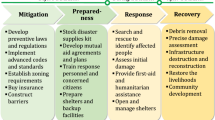Abstract
Geological disasters are mostly located in the mined area of the mine, which mainly shows the characteristics of suddenness, mass occurrence, induction, regional, diversity, and great harm. Mine geological disasters often bring heavy casualties and property losses, and their social impact is huge. This paper studied the characteristics and inducing factors of typical geological disasters in mines, pertinently studied the inducing internal and external factors of geological disasters, analyzed the chain relationship and main characteristics of mine geological disasters, and studied the close relationship between the breeding, inducing, and formation of different geological disasters and environmental geology in mining areas. These disasters will have cumulative effects over time; the interaction between disasters is likely to form a chain reaction and have a serious impact on the mining area and surrounding areas. Using the analytic hierarchy process, a risk assessment system of mine geological disasters with 10 indexes is constructed from three aspects: geological conditions, natural conditions, and human activities. The analytic hierarchy process (AHP) structure model was established, and the comprehensive evaluation model of mine geological disaster risk was established through the research of AHP research. A comprehensive analysis of mine geological disaster risk in the recent 10 years was conducted to study the changing trend of different evaluation indicators. The key indicators affecting geological disasters were obtained, which provided theoretical support for mine geological disaster prediction.








Similar content being viewed by others
References
Chen B (2020) Stress-induced trend: the clustering feature of coal mine disasters and earthquakes in China. Int J Coal Sci Technol 7(4):676–692
Cheng X, Qiao W, Li G, Yu Z (2021) Risk assessment of roof water disaster due to multi-seam mining at Wulunshan Coal Mine in China. Arab J Geosci 14(12):1–15
Chu C, Muradian N (2016) Safety and environmental implications of coal mining. Int J Environ Pollut 59(2–4):250–268
Hu QF, Cui XM, Yuan DB, Deng XB (2012) Formation mechanism of surface cracks caused by thick seam mining and hazard analysis. J Min Saf Eng, 6.
Jin D W, Liu Y F, Liu Z B, Cheng J Y (2013) New progress of study on major water inrush disaster prevention and control technology in coal mine. Coal science and technology, 1.
Karimnia H, Bagloo H (2015) Optimum mining method selection using fuzzy analytical hierarchy process–Qapiliq salt mine, Iran. Int J Min Sci Technol 25(2):225–230
Liu J, Yang B, Yuan S, Li L, Duan L (2020) A fuzzy analytic hierarchy process model to assess the risk of disaster reduction due to grouting in coal mining. Arab J Geosci 13(5):1–15
Ma P (2020) Study on evolution characteristics and transformation mechanism of loess geohazards chain. Xi’an, Chang’an University.
Mu Z, Dou L, He H, Fan J (2013) F-structure model of overlying strata for dynamic disaster prevention in coal mine. Int J Min Sci Technol 23(4):513–519
Nong Z, Dong-jiang P, Yi-ming Z, Chong-mao L, Hai W (2014) Evaluation of relative mining intensity in western China based on interval analytic hierarchy process. Electron J Geotech Eng 19:2941–2953
Peili GONG, Wei LI (2018) Application of transient electromagnetic method in collapse hazard of goaf: take the investigation of the goaf in Shendong coal mine as an example. J Geomech 24(3):416–423
Shao L (2019) Geological disaster prevention and control and resource protection in mineral resource exploitation region. Int J Low Carbon Technol 14(2):142–146
Tan K, Qiao J (2020) Development history and prospect of remote sensing technology in coal geology of China. Int J Coal Sci Technol 7(2):311–319
Tao Z, Zhang H, Chen Y, Jiang C (2016) Support principles of NPR bolt/cable and control techniques of large-deformation disasters. Int J Min Sci Technol 26(6):967–973
Wang F, Zhang P, Cui B, Sun Z, Zhang K (2021) Research progress of disaster factors and a prevention alarm index of coal and gas outbursts. Arab J Geosci 14(19):1–10
Xiao W, Hu Z, Fu Y (2014) Zoning of land reclamation in coal mining area and new progresses for the past 10 years. Int J Coal Sci Technol 1(2):177–183
Xu X, Peng S, Yang F (2018) Development of a ground penetrating radar system for large-depth disaster detection in coal mine. J Appl Geophys 158:41–47
Yan B, Guo Q, Ren F, Cai M (2020a) Modified Nishihara model and experimental verification of deep rock mass under the water-rock interaction. Int J Rock Mech Min Sci 128:104250
Yan B, Wang P, Ren F, Guo Q, Cai M (2020b) A review of mechanical properties and constitutive theory of rock mass anisotropy. Arab J Geosci 13(12):1–16
Yao B, Bai H, Zhang B (2012) Numerical simulation on the risk of roof water inrush in Wuyang Coal Mine. Int J Min Sci Technol 22(2):273–277
Zhang W (2020) Geological disaster monitoring and early warning system based on big data analysis. Arab J Geosci 13(18):1–9
Zhang J, Yang T (2018) Study of a roof water inrush prediction model in shallow seam mining based on an analytic hierarchy process using a grey relational analysis method. Arab J Geosci 11(7):1–12
Zhang L, Li GJ, Zhou ZG, Wang Q (2009) Grey clustering method-based zoning assessment of regional geological disaster. J Nat Disasters 18(1):164–168
Zhu X, Peng J, Tong X, Ma P (2017) Preliminary research on geological disaster chains in loess area. J Eng Geol 25(1):117–122
Funding
This work was supported by the fellowship of the China Postdoctoral Science Foundation (Grant No. 2021M701540) and the key research program of China Coal Science and Industry Group (Grant No. 2019–2-ZD003).
Author information
Authors and Affiliations
Corresponding author
Ethics declarations
Conflict of interest
The authors declare no competing interests.
Additional information
Communicated by Murat Karakus.
Rights and permissions
About this article
Cite this article
Yan, B., Liu, J., Qi, Q. et al. Study on chain relationship and risk assessment model of coal mine geological disasters. Arab J Geosci 15, 900 (2022). https://doi.org/10.1007/s12517-022-10184-5
Received:
Accepted:
Published:
DOI: https://doi.org/10.1007/s12517-022-10184-5




